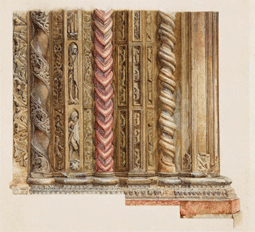Door Jamb, North Door, Santa Maria Maggiore, Bergamo
Frank Randal (1852-1917). Watercolour on paper, 1885
WorkThis 'jamb' supports the left side of the door on the northern transept, or left-hand wing of the Basilica of Santa Maria Maggiore, Bergamo.Santa Maria Maggiore is unusual in that it has no central doorway; instead, the main entrances are to the side, under each transept. This is because the central wall of the church was once part of the Bishop's palace. Both doors are decorated by elaborate porches, which were individually carved by Giovanni da Campione during the 1350s and 60s. The jamb is carved in two colours of marble. The red marble comes from Verona, to the east of Bergamo. The white marble comes from Carrara, to the south. Each column is carved differently with barley twists, figures of knights, scrolling leaves and parades of animals. Randal was painting in Italy under commission from Ruskin, who had asked him to paint records of architecture in 'rather out of the way bits that are perishing.' (Works, 30, p. lxxi). He had spent the winter in Lecco near Lake Como, and moved on to Bergamo, situated to the east of Milan in the Spring.
ArtistFrank Randal (1852-1917) was born in Paddington, London, to Charles Hayter Randal and Frances (née Arnold). Little is known of Randal, but Ruskin commissioned more works from him than any other artist in the Ruskin Collection. He caught the attention of Ruskin in 1881, who started to commission work from him. This continued until 1887. Over this time, he produced at least 137 drawings and watercolours for the Guild. Collection of the Guild of St George, Museums Sheffield
Randal later worked for Sir Sydney Cockerell, painting architectural records for the Society for the Preservation of Pictorial Records of Ancient Works of Art and painting commissions. This included a number for a prominent Sheffield art collector, George Parkes Wall, who was founder of the Pluto Steelworks. Randal had a brother Charles (described in the 1881 census as a photographer, and in the 1891 census as an artist and sculptor), and a sister, Fanny Scott Randal. A sketch of W. G. Collingwood, Ruskin and Randal was drawn on a letter that Charles sent to Fanny. -----
[The information concerning Randal's family connections was kindly supplied by Philippa Robertson of Morrinsville, New Zealand, the great great grandaughter of Randal's uncle, John Lawrence Randal, an architect at Shrewsbury.]----- Ruskin on Gothic CarvingRuskin admired the kind of individual and imaginative carving exemplified by this jamb, terming it Lombardic Gothic.In 'Verona, and its Rivers' (1870), he paid attention to the style's characteristic mixture of plants, shapes, figures and animals. He concluded that there 'was nothing in architecture at once so exquisite, and so wild, and so strange in the expression of self-conquest, achieved almost as in a dream' (Works, 19, p. 436). |



















